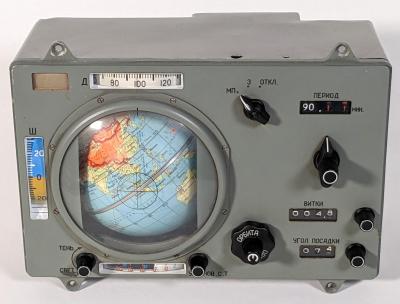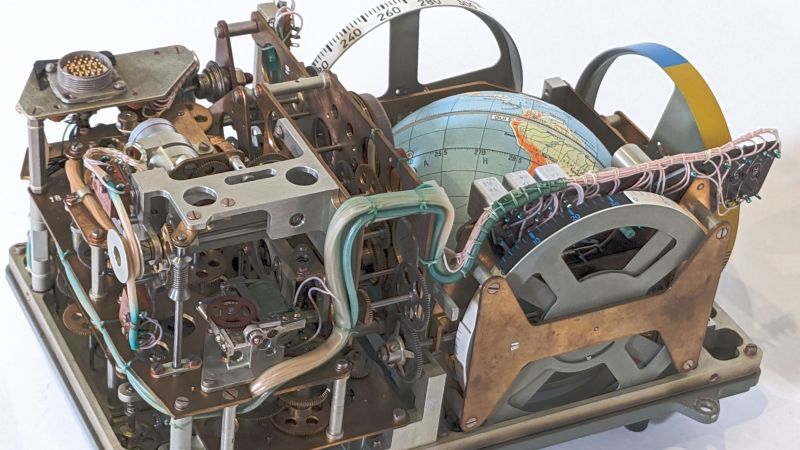Whenever [Ken Shirriff] posts something, it ends up being a fascinating read. Usually it’s a piece of computer history, decapped and laid bare under his microscope where it undergoes reverse engineering and analysis to a degree that should be hard to follow, but he still somehow manages to make it understandable. And the same goes for this incredible Soviet analog flight computer, even though there’s barely any silicon inside.
 The artifact in question was officially designated the “Индикатор Навигационный Космический,” which roughly translates to “space navigation indicator.” It mercifully earned the nickname “Globus” at some point, understandable given the prominent mechanized globe the device features. Globus wasn’t actually linked to any kind of inertial navigation inputs, but rather was intended to provide cosmonauts with a visual indication of where their spacecraft was relative to the surface of the Earth. As such it depended on inputs from the cosmonauts, like an initial position and orbital altitude. From there, a complicated and absolutely gorgeous gear train featuring multiple differential gears advanced the globe, showing where the spacecraft currently was.
The artifact in question was officially designated the “Индикатор Навигационный Космический,” which roughly translates to “space navigation indicator.” It mercifully earned the nickname “Globus” at some point, understandable given the prominent mechanized globe the device features. Globus wasn’t actually linked to any kind of inertial navigation inputs, but rather was intended to provide cosmonauts with a visual indication of where their spacecraft was relative to the surface of the Earth. As such it depended on inputs from the cosmonauts, like an initial position and orbital altitude. From there, a complicated and absolutely gorgeous gear train featuring multiple differential gears advanced the globe, showing where the spacecraft currently was.
Those of you hoping for a complete teardown will be disappointed; the device, which bears evidence of coming from the time of the Apollo-Soyuz collaboration in 1975, is far too precious to be taken to bits, and certainly looks like it would put up a fight trying to get it back together. But [Ken] still manages to go into great depth, and reveals many of its secrets. Cool features include the geopolitically fixed orbital inclination; the ability to predict a landing point from a deorbit burn, also tinged with Cold War considerations; and the instrument’s limitations, like only supporting circular orbits, which prompted cosmonauts to call for its removal. But versions of Globus nonetheless appeared in pretty much everything the Soviets flew from 1961 to 2002. Talk about staying power!
Sure, the “glass cockpit” of modern space vehicles is more serviceable, but just for aesthetics alone, we think every crewed spacecraft should sport something like Globus. [Ken] did a great job reverse-engineering this, and we really appreciate the tour. And from the sound of it, [Curious Marc] had a hand in the effort, so maybe we’ll get a video too. Fingers crossed.
Thanks to [saintaardvark] for the tip.
















Wow fascinating and great to see. I really appreciate a proper write up, and [Ken] never disappoints. Video only needed if he can get something moving.
The most Kerbal thing I’ve seen today.
Kinda freaky. I was literally just reading up on this gizmo last night.
Top tec, hope for no more Texas instruments chips on Rússian missiles
I’ve always thought those things were so cool but never knew much about it, thanks for the writeup.
I guess “favourite instrument from a spacecraft” is a pretty niche category, but this instrument (display?) has always fascinated me since I first became aware of it. It’s such a simple concept, although from Ken’s write up, it’s clearly anything but simple in operation.
Better than Orbitron… Karascho !
As an European, I kind of love old Soviet tech. Well, some of it.
This one is somewhat down to earth, yet elegant.
Even if the mechanic is to complicated to replicate,
I would really wish that a replica would still be made someday.
Say, a hybrid design consisting of a digital computer and the mechanical globe.
Making the globe rotate isn’t nearly as complicated as computing actual position through mechanic.
The original one is like a highly complicated and precise clock mechanism.
How cool would it be to build a modern version of this? Not just a replica that looks the same on the face plate but an honest update of the technology. Maybe as a tertiary backup to GNSS, chip sized inertial trackers, and VOR/DME/VORTAC beacons receivers.
I’d still want the primary systems talking to it for up to date calibration but it would be a neat tool to have. I’ve seen bird strikes rip off antennas, and the aftermath of engine parts leaving at right angles. Having a hardened “analogue” position tracker may come in handy. Might as well throw in a ring laser gyroscope for aesthetic retro glowing effects.
I would love to see a replica of this used as a satnav display. A couple of steppers to move the globe and it shows where you are on the surface…. Or something like James Bond’s “Homer” in Goldfinger, that uses a light projected theough a transparency of a map. Sigh, more projects for the to-do list.
Anthykitera
Wow at the time this ancient looking contraption was made the Americans were using a space appollo computer with integrated circuits in it some were even surface mount parts no wonder the Russians never went to the moon I notice it contains a few electronic parts what looks like micro modules but the Americans had the roswell spaceship to get their technology the Soviets were stuck with something like a copy of the ancient Greek navigation computer they discovered in a ship wreck
The USSR and Russia is a big place. How do you know they didn’t get a saucer crash? Given their political arrangement, even easier to keep things quiet.